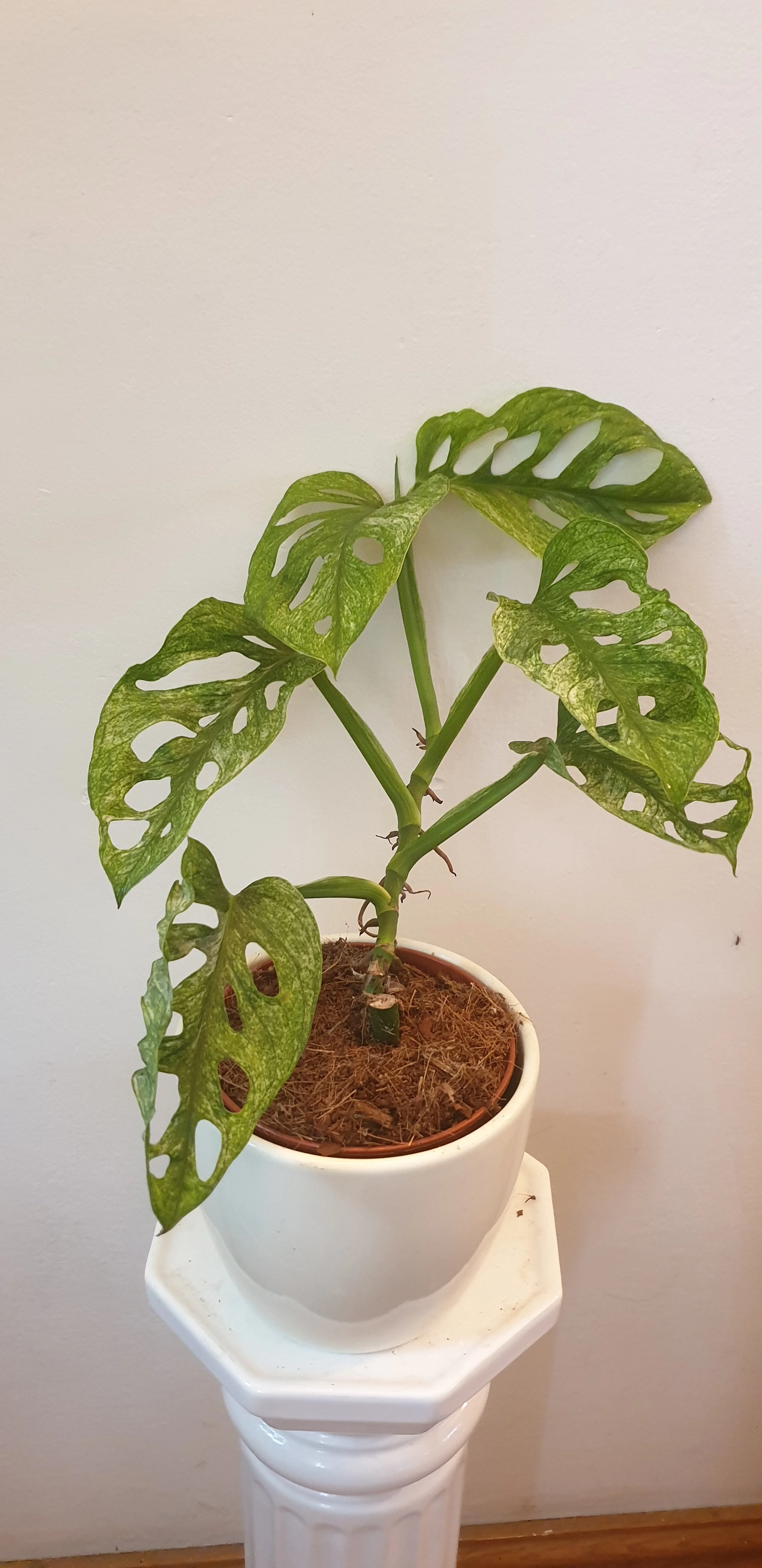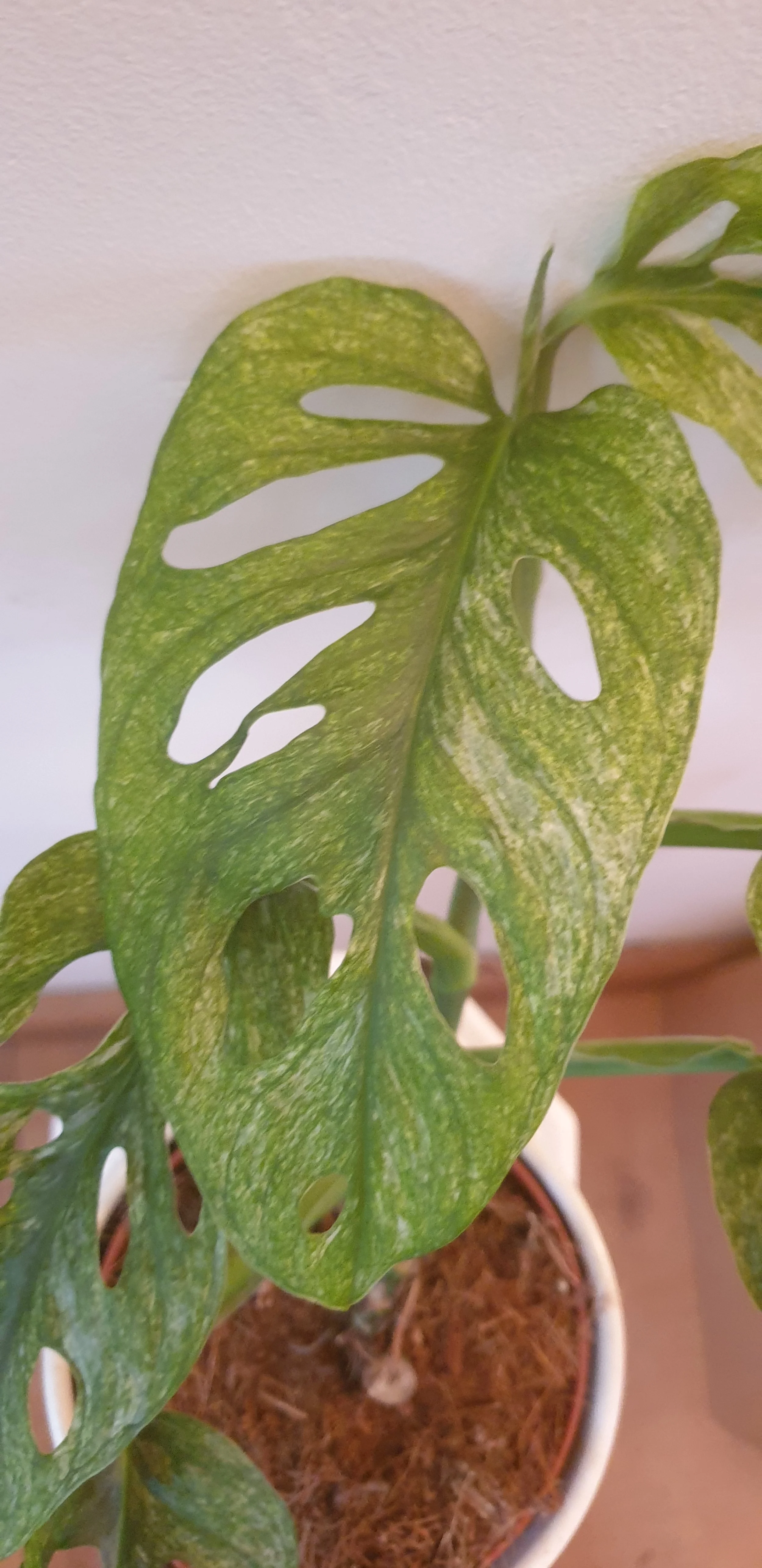 Image 1 of 2
Image 1 of 2

 Image 2 of 2
Image 2 of 2



Monstera 'Mint' in 12cm pot, minimum 6 leaves.
🌿 What is Monstera “Mint”
“Mint Monstera” belongs to a group of variegated monstera plants, often Monstera deliciosa or related large‑leaf Monsteras, that show variegation in soft, mint‑green to pale green or cream tones rather than stark white.
Some key features:
Leaves have marbled, patchy or sectorial variegation — light mint/green/cream areas blending with darker green.
As it matures and when conditions are good, the leaves develop fenestrations (splits and holes), like other Monsteras.
Growth tends to be slower compared to fully green Monsteras (and even compared to some variegated ones like Albo) because variegated portions have less chlorophyll.
Occasionally there is confusion between “Mint” vs “Albo / Variegata / Thai Constellation” varietals, so verifying seller authenticity (photos, variegation stability) is important.
---
🪴 Monstera Mint Care Guide
Because of its variegation and rarity, Monstera ‘Mint’ tends to need a bit more careful conditions than plain green Monsteras. Here are best practices:
Factor What it Needs
Light Bright, indirect light is essential. The variegated (lighter) areas need good light to produce energy. Too little will cause variegation to fade or leaves to grow poorly. Avoid harsh direct sunlight, especially midday, which can burn the lighter patches.
Watering Keep soil evenly moist but not waterlogged. Allow the top ~2‑3 cm of soil to dry before watering again. Overwatering can lead to root rot; underwatering will cause wilting, browning edges.
Soil / Potting Mix Use a well‑draining, airy mix. Aroid‑type mix with components like orchid bark, perlite, coco coir, maybe charcoal works well. Allows roots to breathe and avoids soggy substrate.
Humidity Prefers higher humidity, ideally 60‑80%+. Dry air especially harms the variegated parts (edges burn or brown). Using a humidifier, grouping plants, pebble tray, or placing near moist rooms helps.
Temperature Warm, stable temps: about 18‑29 °C (65‑85 °F) is ideal. Avoid cold drafts, sudden drops below ~13‑15 °C which can stress it.
Fertilizer / Feeding During active growing season (spring through summer), feed every ~4‑6 weeks with a balanced (but diluted) fertilizer. Because variegated parts have less chlorophyll, the plant is more sensitive to overfertilization. <br> During fall/winter reduce feeding.
Support / Growth Habit It’s a climbing plant. Provide a moss pole, trellis, or similar support to encourage upright growth and larger fenestrated leaves. Leaves that climb produce larger, more dramatic fenestrations.
Repotting Repot every 1‑2 years (or earlier if rootbound). Use pot with good drainage. Don’t choose a pot too large or soil too dense.
Variegation Stability Keep an eye on the variegation: very pale or very white zones may burn or die off if they don’t get enough light. Some variegated leaves may revert to green if conditions are poor. Select cuttings from well‑variegated mature leaves if you're propagating.
---
⚠️ Things to Watch Out For & Common Problems
Leaf burn or brown edges on variegated sections from too much direct light or low humidity.
Slow or no growth, particularly during winter or if light is low.
Yellow leaves can mean overwatering or poor drainage.
Loss of variegation (i.e. new leaves are more green than mint/cream) if light is insufficient or if the plant is under stress.
Pest issues: Spider mites, scale, etc., especially when humidity fluctuates. Regular checks help.
Toxicity: Like all monsteras, it contains calcium oxalate crystals, which are irritating/toxic if ingested by pets or children. Keep out of reach.
🌿 What is Monstera “Mint”
“Mint Monstera” belongs to a group of variegated monstera plants, often Monstera deliciosa or related large‑leaf Monsteras, that show variegation in soft, mint‑green to pale green or cream tones rather than stark white.
Some key features:
Leaves have marbled, patchy or sectorial variegation — light mint/green/cream areas blending with darker green.
As it matures and when conditions are good, the leaves develop fenestrations (splits and holes), like other Monsteras.
Growth tends to be slower compared to fully green Monsteras (and even compared to some variegated ones like Albo) because variegated portions have less chlorophyll.
Occasionally there is confusion between “Mint” vs “Albo / Variegata / Thai Constellation” varietals, so verifying seller authenticity (photos, variegation stability) is important.
---
🪴 Monstera Mint Care Guide
Because of its variegation and rarity, Monstera ‘Mint’ tends to need a bit more careful conditions than plain green Monsteras. Here are best practices:
Factor What it Needs
Light Bright, indirect light is essential. The variegated (lighter) areas need good light to produce energy. Too little will cause variegation to fade or leaves to grow poorly. Avoid harsh direct sunlight, especially midday, which can burn the lighter patches.
Watering Keep soil evenly moist but not waterlogged. Allow the top ~2‑3 cm of soil to dry before watering again. Overwatering can lead to root rot; underwatering will cause wilting, browning edges.
Soil / Potting Mix Use a well‑draining, airy mix. Aroid‑type mix with components like orchid bark, perlite, coco coir, maybe charcoal works well. Allows roots to breathe and avoids soggy substrate.
Humidity Prefers higher humidity, ideally 60‑80%+. Dry air especially harms the variegated parts (edges burn or brown). Using a humidifier, grouping plants, pebble tray, or placing near moist rooms helps.
Temperature Warm, stable temps: about 18‑29 °C (65‑85 °F) is ideal. Avoid cold drafts, sudden drops below ~13‑15 °C which can stress it.
Fertilizer / Feeding During active growing season (spring through summer), feed every ~4‑6 weeks with a balanced (but diluted) fertilizer. Because variegated parts have less chlorophyll, the plant is more sensitive to overfertilization. <br> During fall/winter reduce feeding.
Support / Growth Habit It’s a climbing plant. Provide a moss pole, trellis, or similar support to encourage upright growth and larger fenestrated leaves. Leaves that climb produce larger, more dramatic fenestrations.
Repotting Repot every 1‑2 years (or earlier if rootbound). Use pot with good drainage. Don’t choose a pot too large or soil too dense.
Variegation Stability Keep an eye on the variegation: very pale or very white zones may burn or die off if they don’t get enough light. Some variegated leaves may revert to green if conditions are poor. Select cuttings from well‑variegated mature leaves if you're propagating.
---
⚠️ Things to Watch Out For & Common Problems
Leaf burn or brown edges on variegated sections from too much direct light or low humidity.
Slow or no growth, particularly during winter or if light is low.
Yellow leaves can mean overwatering or poor drainage.
Loss of variegation (i.e. new leaves are more green than mint/cream) if light is insufficient or if the plant is under stress.
Pest issues: Spider mites, scale, etc., especially when humidity fluctuates. Regular checks help.
Toxicity: Like all monsteras, it contains calcium oxalate crystals, which are irritating/toxic if ingested by pets or children. Keep out of reach.